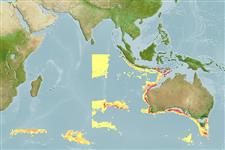Elasmobranchii (tubarões e raias) (sharks and rays) >
Carcharhiniformes (Ground sharks) >
Scyliorhinidae (Cat sharks) > Scyliorhininae
Etymology: Cephaloscyllium: cephalus, from kephale (Gr.), head, referring to its very broad and depressed head; skylion, Greek for dogfish or small shark (See ETYFish); hiscosellum: hisco (L.), open; sella (L.), saddle, referring to distinctive open-centered saddle-like markings that dominate its color pattern (See ETYFish).
Environment: milieu / climate zone / depth range / distribution range
Ecologia
marinhas batipelágico; intervalo de profundidade 294 - 420 m (Ref. 76949). Subtropical
Eastern Indian Ocean: Australia.
Comprimento de primeira maturação / Tamanho / Peso / Idade
Maturity: Lm 46.0, range 46 - 46.3 cm
Max length : 46.3 cm TL macho/indeterminado; (Ref. 76949); 52.0 cm TL (female)
Descrição suscinta
Chaves de identificação | Morfologia | Morfometria
A small species with the following characters: head 8.9-13.1% TL in height, trunk width 12.9-19.1% TL; origin of first dorsal-fin usually over mid pelvic-fin base; prenarial length 4.5-5.2% TL; preorbital snout length 1.4-1.6 times prenarial length, 2.6-3.1 in prepectoral length, 5.9-6.7 in prepelvic length; snout-vent length long, 46.2-51.2% TL; nostril 2.5-3.1% TL in width; eye-spiracle space wide, 0.8-1.2% TL; pectoral fin moderate-sized, height 8.7-12.2% TL, posterior margin length 7.4-11.4% TL; anal fin relatively low, height 2.8-3.7% TL; anal-caudal space 5.4-6.5% TL; precaudal length 76.4-79.2% TL; interdorsal space 7.4-9.6% TL; teeth with 3-5 cusps near symphysis of upper jaw; flank denticles are mainly unicuspidate; back without greatly enlarged denticles; long adult clasper, up to 9.3% TL, reaching anal-fin origin; vertebral centra 100-108; low tooth count, each jaw with teeth between 45 and 63; dorsal surface with a striking pattern of dark brown, open-centered saddles (Ref. 76949).
Ciclo de vida ou comportamento de acasalamento
Maturidade | Reprodução | Desova | Ovos | Fecundidade | Larvas
White, W.T. and D.A. Ebert, 2008. Cephaloscyllium hiscosellum sp. nov., a new swell shark (Carcharhiniformes: Scyliorhinidae) from Northwestern Australia. pp. 147-157. In P.R. Last, W.T. White and J.J. Pogonoski (eds). Descriptions of new Australian chondrichthyans. CSIRO Marine and Atmospheric Research Paper no. 22. 365 p. (Ref. 76949)
Status na Lista Vermelha da UICN (Ref. 130435: Version 2024-2)
Ameaça para os humanos
Harmless
Uso pelos humanos
Ferramentas
Relatórios especiais
Baixar XML
Fontes da internet
Estimates based on models
Preferred temperature (Ref.
123201): 7.7 - 12.5, mean 11.8 °C (based on 14 cells).
Índice de diversidade filogenética (Ref.
82804): PD
50 = 0.5000 [Uniqueness, from 0.5 = low to 2.0 = high].
Bayesian length-weight: a=0.00263 (0.00138 - 0.00502), b=3.21 (3.04 - 3.38), in cm total length, based on LWR estimates for this (Sub)family-body shape (Ref.
93245).
Nível Trófico (Ref.
69278): 4.0 ±0.5 se; based on size and trophs of closest relatives
Resiliência (Ref.
120179): Baixo, tempo mínimo de duplicação da população 4,5 - 14 anos (Preliminary low fecundity).
Fishing Vulnerability (Ref.
59153): Moderate vulnerability (41 of 100).
